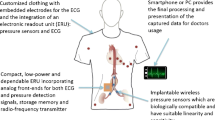Abstract
Wireless sensor nodes that can be strategically located across the human body to create a network for various types of healthcare applications such as a network is known as wearable computing devices (WCDs). Robust treatment is provided to the patient in this network, to maintain stable patient status. The coordination in the effective route needs to be improved. Patient care should be maintained in WCD and communicated more in a reliable manner. In general data from such a network is vulnerable to attacks/misbehavior. Hence it is warranted to detect and introduce methods for sustaining the reliability of the network. Data classification methods by selecting classification algorithms, fuzzy unordered rule induction algorithm (FURIA) have been introduced in this research as a possible solution to address the problem. An attempt has also been made to detect faulty measurements while collecting data from the WCD and the data has been securely transmitted through fuzzy logic technique. The main objective of this research is to introduce alarming techniques when the patient goes critical. The proposed FURIA based classification and linear regression algorithm outperforms existing methods.









Similar content being viewed by others
References
AbdulGhaffar A, Mostafa SM, Alsaleh A, Sheltami T, Shakshuki EM (2020) Internet of Things based multiple disease monitoring and health improvement system. J Ambient Intell Humaniz Comput 11(3):1021–1029
Ahriz I, Douin JM, Lemoine F, Wei A (2018) Performance evaluations in optical and wireless networks for CONDOR project. Procedia Comput Sci 130:73–81
Akyildiz IF, Su W, Sankarasubrarnanian Y, Cayirci E (2002) Wireless sensor networks: a survey. Comput Netw Elsevier Sci 38(4):393–422
Baskar S, Shakeel PM, Kumar R, Burhanuddin MA, Sampath R (2020) A dynamic and interoperable communication framework for controlling the operations of wearable sensors in smart healthcare applications. Comput Commun 149:17–26
Caroppo A, Leone A, Siciliano P (2017) Objective assessment of physical activity and sedentary time of older adults using ambient and wearable sensor technologies. J Ambient Intell Humaniz Comput. https://doi.org/10.1007/s12652-017-0610-5
Devarajan M, Subramaniyaswamy V, Vijayakumar V, Ravi L (2019) Fog-assisted personalized healthcare-support system for remote patients with diabetes. J Ambient Intell Humaniz Comput 10(10):3747–3760
Dhulipala VS, Kanagachidambaresan GR (2014) Cardiac care assistance using self configured sensor network—a remote patient monitoring system. J Inst Eng (India) Ser B 95(2):101–106
Goldberger AL, Amaral LA, Glass L, Hausdorff JM, Ivanov PC, Mark RG, Stanley HE (2000) PhysioBank, PhysioToolkit, and PhysioNet: components of a new research resource for complex physiologic signals. Circulation 101(23):e215–e220
Haque SA, Aziz SM (2013) False alarm detection in cyber-physical systems for healthcare applications. Aasri Procedia 5:54–61
Haque SA, Rahman M, Aziz SM (2015) Sensor anomaly detection in wireless sensor networks for healthcare. Sensors 15(4):8764–8786
Hauskrecht M, Batal I, Valko M, Visweswaran S, Cooper GF, Clermont G (2013) Outlier detection for patient monitoring and alerting. J Biomed Inform 46(1):47–55
Hühn J, Hüllermeier E (2009) FURIA: an algorithm for unordered fuzzy rule induction. Data Min Knowl Disc 19(3):293–319
Khan A, Shah R, Imran M, Khan A, Bangash JI, Shah K (2019) An alternative approach to neural network training based on hybrid bio meta-heuristic algorithm. J Ambient Intell Humaniz Comput 10(10):3821–3830
Mamun Q, Islam MR, Kaosar M (2014) Anomaly detection in wireless sensor network. JNW 9(11):2914–2924
Manogaran G, Shakeel PM, Fouad H, Nam Y, Baskar S, Chilamkurti N, Sundarasekar R (2019) Wearable IoT smart-log patch: an edge computing-based Bayesian deep learning network system for multi access physical monitoring system. Sensors 19(13):3030
Movassaghi S, Abolhasan M, Lipman J, Smith D, Jamalipour A (2014) Wireless body area networks: a survey. IEEE Commun Surv Tutor 16(3):1658–1686
Qidwai U, Chaudhry J, Jabbar S, Zeeshan HMA, Janjua N, Khalid S (2019) Using casual reasoning for anomaly detection among ECG live data streams in ubiquitous healthcare monitoring systems. J Ambient Intell Humaniz Comput 10(10):4085–4097
Salem O, Guerassimov A, Mehaoua A, Marcus A, Furht B (2013a) Anomaly detection scheme for medical wireless sensor networks. Handbook of medical and healthcare technologies. Springer, New York, pp 207–222
Salem O, Liu Y, Mehaoua A (2013b) Detection and isolation of faulty measurements in medical Wireless Sensor Networks. In: 2013 First International Symposium on Future Information and Communication Technologies for Ubiquitous HealthCare (Ubi-HealthTech). IEEE, pp 1–5
Salem O, Guerassimov A, Mehaoua A, Marcus A, Furht B (2014a) Anomaly detection in medical wireless sensor networks using SVM and linear regression models. Int J E-Health Med Commun (IJEHMC) 5(1):20–45
Salem O, Liu Y, Mehaoua A, Boutaba R (2014b) Online anomaly detection in wireless body area networks for reliable healthcare monitoring. IEEE J Biomed Health Inform 18(5):1541–1551
Salem O, Serhrouchni A, Mehaoua A, Boutaba R (2018) Event detection in wireless body area networks using Kalman filter and power divergence. IEEE Trans Netw Serv Manag 15(3):1018–1034
Shakeel PM, Baskar S (2020) Automatic human emotion classification in web document using fuzzy inference system (FIS): human emotion classification. Int J Technol Hum Interact (IJTHI) 16(1):94–104
Shubha BB, Waheed S, Rhythom KS (2015) False alarm detection in wireless body sensor network using adaptive and intelligent approach. Communications 3:1–9
Smrithy GS, Balakrishnan R, Sivakumar N (2019) Anomaly detection using dynamic sliding window in wireless body area networks. Data science and big data analytics. Springer, Singapore, pp 99–108
Ullah F, Ullah Z, Ahmad S, Islam IU, Rehman SU, Iqbal J (2019) Traffic priority based delay-aware and energy efficient path allocation routing protocol for wireless body area network. J Ambient Intell Humaniz Comput 10(10):3775–3794
Yilmaz T, Foster R, Hao Y (2010) Detecting vital signs with wearable wireless sensors. Sensors 10(12):10837–10862
Zhan Y, Kuroda T (2014) Wearable sensor-based human activity recognition from environmental background sounds. J Ambient Intell Humaniz Comput 5(1):77–89
Zhang Y, Hamm NA, Meratnia N, Stein A, Van De Voort M, Havinga PJ (2012) Statistics-based outlier detection for wireless sensor networks. Int J Geogr Inform Sci 26(8):1373–1392
Zhang M, Raghunathan A, Jha NK (2013) MedMon: Securing medical devices through wireless monitoring and anomaly detection. IEEE Trans Biomed Circuits Syst 7(6):871–881
Acknowledgements
Author M. G. Sharavana Kumar wishes to acknowledge the University Grants Commission (UGC) India. Grant no. F1-17.1/2016-17/RGNF-2015-17-SC-TAM-7557 /(SA-III/Website)
Author information
Authors and Affiliations
Corresponding author
Additional information
Publisher's Note
Springer Nature remains neutral with regard to jurisdictional claims in published maps and institutional affiliations.
Rights and permissions
About this article
Cite this article
Kumar, M.G.S., Dhulipala, V.R.S. & Baskar, S. Fuzzy unordered rule induction algorithm based classification for reliable communication using wearable computing devices in healthcare. J Ambient Intell Human Comput 12, 3515–3526 (2021). https://doi.org/10.1007/s12652-020-02219-0
Received:
Accepted:
Published:
Issue Date:
DOI: https://doi.org/10.1007/s12652-020-02219-0




